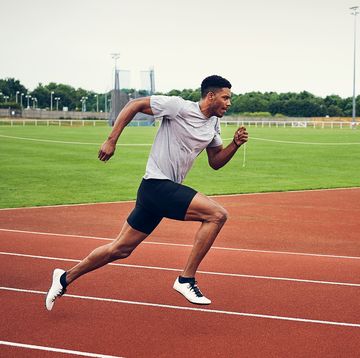There’s nothing more demoralising than trying to run at your goal race pace in training. Personally, I’ve seldom managed to run even half my race distance at goal pace; and on the rare occasions that I try something like that, I’m always left wondering: “How on earth am I going to run twice as far, but faster, in a race?”
How to get started on the running track can perform seemingly impossible feats once the starting gun fires. There are many different factors at work: you’re rested and tapered, your motivation is higher, you have competitors to measure yourself against, and so on. But how does all that actually translate into faster running?
An abstract presented at the European College of Sports Science’s annual congress in Vienna last month offers some insights. Marco Konings and his colleagues at the University of Essex investigated the effects of competition on the different types of fatigue that show up in your brain and muscles.
The study involved cyclists who did a pair of 4-kilometre time trials, once alone and once against a virtual competitor (in random order). Not surprisingly, they were able to go faster when pitted against the virtual competitor (6:22.2, on average, versus 6:33.6).
Before and after each time trial, the researchers asked the cyclists to give a “maximal voluntary contraction” of their leg muscles, and then used electrical stimulation to see how much extra force could be shocked out of the muscle. This allowed them to calculate “peripheral” fatigue (how much weaker the muscle itself was after the time trial) and “central” fatigue (how much weaker the signal from the brain to the muscle was after the time trial).
The results showed that central fatigue was pretty much the same in both cases (a decrease of 4.9 percent in the competitive race versus 3.4 percent in the solo trial). But peripheral fatigue was much greater in the competitive race, decreasing by 23.1 percent versus just 16.2 percent in the solo trial.
The implication, the authors write, is that “the presence of a competitive opponent seems to enable the participants to use a greater degree of their physiologic capacity,” thanks to a “willingness to tolerate higher levels of peripheral fatigue.”
There is, indeed, evidence that sustained hard exercise generates metabolites (in particular lactate, hydrogen ions, and ATP) in your muscles that send a signal back to the brain that is interpreted as pain. So if you’re willing to ignore that pain for a little longer, you can presumably perform better.
It’s worth noting that these measurements are complex and depend a lot on the details of the experiment. The degree of peripheral fatigue may depend in part on how you pace yourself: a slow start and big sprint finish may generate a different balance of peripheral and central fatigue compared to a fast start and gradual fade.
In other words, “we run better in competition because we’re willing to tolerate more muscle pain” probably isn’t the full explanation of the magic of racing. But it’s a start - and a useful reminder that training and racing aren’t the same thing.
The question that I’m left wondering about is whether it’s better to learn to access more and more of that physiologic reserve in training, or whether it’s better to save those final gears for when they’re really needed in races. As an athlete, my intuition was always the latter - but I’ve certainly heard plenty of war stories from great athletes who could deliver race-quality efforts in workouts.













